Welcome to the fascinating world of porcupine teeth, where nature’s design showcases their stunning coloration and impressive growth. These remarkable teeth are not only functional but also play a key role in the survival of these intriguing creatures. Let’s delve into the captivating details of porcupine teeth and unravel their secrets.
- Porcupine teeth are a shade of red or orange due to the iron oxide present in their enamel.
- The iron in their teeth helps porcupines chew on tough plant material like trees and branches.
- Porcupine teeth never stop growing, so porcupines constantly chew to wear them down.
- Porcupines belong to the rodent family and are relatives of beavers.
- Their diet consists mainly of plants, including tree bark, which contributes to the reddish-orange color of their teeth.
The Red Teeth of Porcupines: A Unique Phenomenon
Step into the world of red-teethed porcupines and uncover the fascinating science behind their unique coloration. While porcupines are commonly known for their sharp quills, their teeth are equally intriguing. Unlike traditional white teeth, porcupine teeth showcase a vibrant shade of red or orange, making them a standout feature among animals.
The red coloration of porcupine teeth is attributed to the presence of iron oxide in their enamel. This high iron content not only gives their teeth a distinctive hue, but it also serves a crucial purpose in their survival. The iron in their teeth provides strength and durability, allowing them to chew on tough items like trees and branches, which are essential components of their herbivorous diet.
Porcupines, hailing from the rodent family and closely related to beavers, sport these uniquely colored teeth as a result of their plant-based diet. As they consume plant material, particularly tree bark, the iron-rich components of their food contribute to the reddish-orange hue of their teeth. It’s a fascinating example of nature’s adaptation and ingenuity.
An image of a red-teethed porcupine in its natural habitat can be seen below:

A Closer Look at Porcupine Teeth: Structure and Function.
Let’s take a closer look at the specialized dental toolkit of porcupines, designed to handle their herbivorous diet and gnaw through tough plant material. Porcupines have four types of teeth: incisors, canines, premolars, and molars. Their incisors are the most prominent and never stop growing, allowing them to continuously gnaw on tough plant matter.
Porcupines are herbivores, which means their diet consists mainly of plants. Their teeth are perfectly adapted for this type of diet. The incisors are sharp and chisel-like, ideal for gnawing through bark, branches, and other tough plant material. Their molars, on the other hand, have flat surfaces with ridges, perfect for grinding and chewing plant matter into a digestible pulp.
“The teeth of porcupines are a fascinating example of nature’s ingenuity. They grow throughout their lifetime, ensuring that porcupines always have the necessary tools to fulfill their dietary needs,” says Dr. Lisa Dent, a renowned animal dentist.
| Tooth Type | Function |
|---|---|
| Incisors | Never stop growing, used for gnawing and chewing tough plant material like bark and branches. |
| Canines | Less prominent, used for gripping and manipulating food. |
| Premolars | Have cusps and ridges, responsible for grinding and shredding plant matter. |
| Molars | Large, flat surfaces, perfect for grinding and chewing food into a digestible consistency. |
“Porcupine teeth are a true testament to nature’s brilliance. Their unique and ever-growing dental structure allows porcupines to thrive in their natural habitat and fulfill their vital role as herbivores,”
The incredible adaptability of porcupine teeth is essential for their survival in the wild. Without strong, continuously growing teeth, porcupines would struggle to consume the tough plant material that makes up their diet. Their teeth provide them with the ability to chew on trees and branches, ensuring they can access the nutritional resources necessary for their well-being.
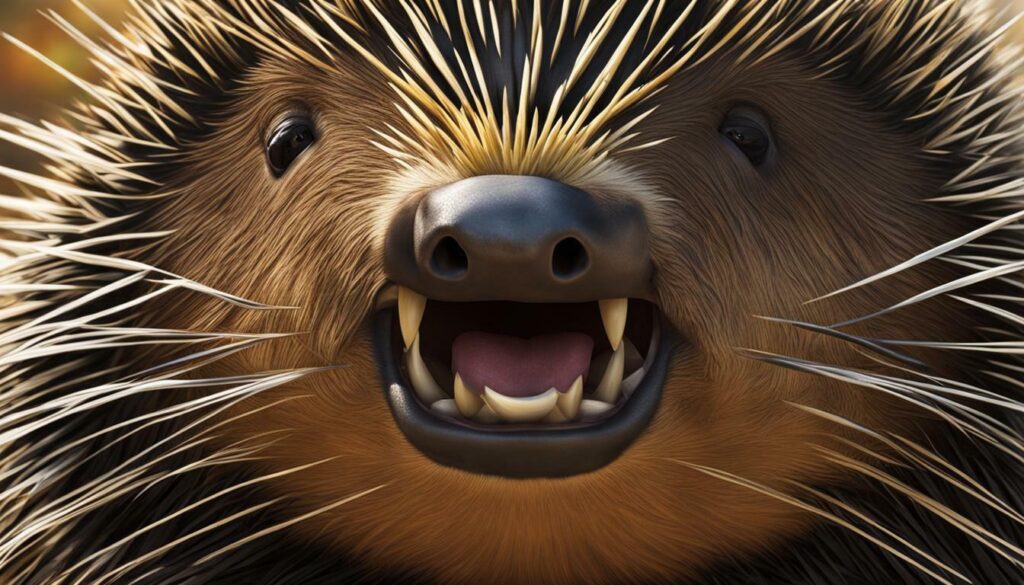
Porcupine teeth are not only unique in their ability to continuously grow but also serve as a prime example of evolutionary adaptation. Their dental structure and function have developed over time, honed to perfection to suit their herbivorous lifestyle. The combination of sharp incisors and sturdy molars enables them to handle even the toughest plant material with ease. This incredible dental adaptation is a true marvel of nature’s design.
- Porcupine teeth grow throughout their lifetime, ensuring they always have the proper tools for their diet.
- Their incisors, specifically, never stop growing, allowing them to effectively gnaw and chew on tough plant matter.
- Porcupines’ teeth are perfectly suited for their plant-based diet, enabling them to consume a wide variety of plant material.
- They play a crucial role in the ecosystem as herbivores, helping to maintain the balance of plant life in their habitat.
As we delve deeper into the intricate design of porcupine teeth, we gain a greater understanding of the remarkable adaptations found in the animal kingdom. Porcupines’ teeth are a true dental masterpiece, showcasing the ingenuity and resilience of nature’s creations.
Porcupine Teeth vs. Quills: The Distinctive Features
Porcupines possess not only unique teeth but also a remarkable defense mechanism in the form of their famous quills. While their teeth are adapted for chewing and consuming food, their quills serve as a highly effective defense mechanism. These sharp and prickly quills are a porcupine’s primary defense when threatened.
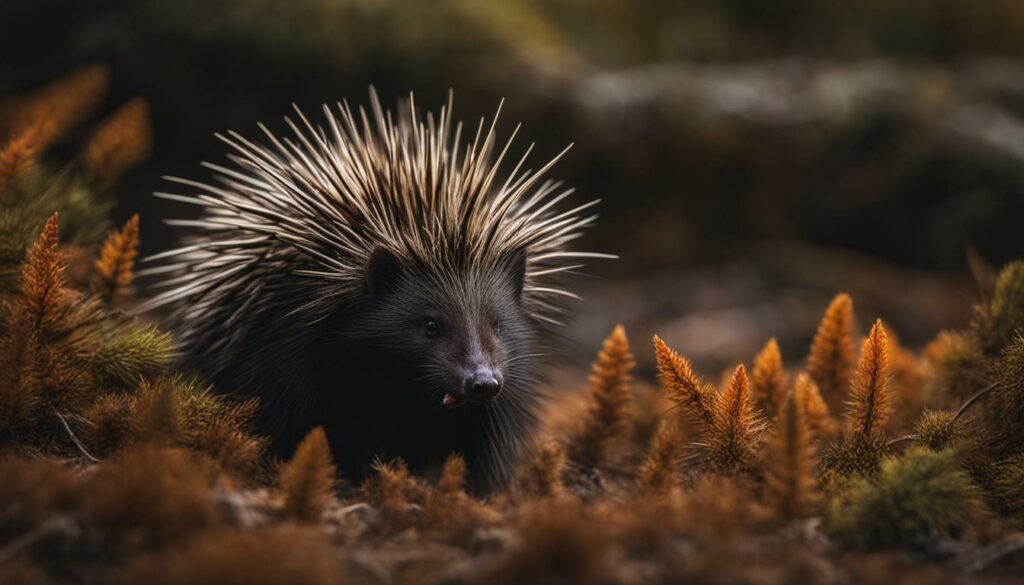
Quills are specially designed to protect porcupines from predators. When a porcupine feels threatened, it raises its quills, creating a barrier that discourages predators from coming into contact. These sharp quills act as a deterrent, ensuring the porcupine’s safety in the wild. As a result, they play a crucial role in the porcupine’s survival.
The quills of a porcupine are just as fascinating as their teeth. They are made of keratin, the same material as our fingernails, and are loosely attached to the porcupine’s body. This allows the quills to detach easily when they come into contact with a predator. However, contrary to popular belief, their teeth are firmly anchored in their jaw, providing strength and durability.
To summarize, while porcupine teeth are adapted for chewing and consuming food, their quills serve as a protective barrier against predators. These sharp and prickly quills are a porcupine’s primary defense mechanism and play a crucial role in their survival. The distinctive features of porcupine teeth and quills reflect the ingenuity of nature’s design.
Porcupine Teeth Growth: A Lifelong Process
Enter the world of never-ending growth as we uncover the fascinating journey of porcupine teeth, which continue to grow throughout their lifetime. Porcupine teeth are truly remarkable, constantly evolving to meet the needs of these fascinating creatures. Their teeth are a key adaptation that allows them to thrive in their unique habitat and play a crucial role in their survival.
Unlike other animals, porcupines have teeth that grow continuously throughout their lives. This constant growth is necessary because porcupines rely on their teeth to gnaw through tough plant material, such as bark and branches. Their herbivorous diet consists mainly of plants, and their teeth are specifically adapted to chew on these items. As their teeth grow, porcupines continuously wear them down through their chewing habits, ensuring that they remain sharp and effective in their feeding activities.
The continuous growth of porcupine teeth is supported by the protective enamel that covers them. Enamel serves as a barrier, safeguarding the teeth from mechanical stress and acid wear. This enamel is particularly strong due to the high iron content in porcupine teeth, which also contributes to their reddish-orange coloration. It’s this iron-rich structure that sets their teeth apart and makes them truly distinctive in the animal kingdom.
Porcupine teeth are a testament to the incredible design found in nature. They are not only functional and essential for survival but also aesthetically fascinating. The never-ending growth of their teeth showcases the resilience and adaptability of these creatures. So, the next time you come across a porcupine, take a moment to appreciate the magnificence of their teeth, a true masterpiece of nature’s ingenuity.
| Key Points |
|---|
| Porcupine teeth grow continuously throughout their lifetime. |
| Their teeth are adapted for chewing tough plant material. |
| Enamel protects porcupine teeth from wear and tear. |
| Porcupine teeth have a high iron content, contributing to their unique coloration. |
| Porcupine teeth are a testament to the incredible design found in nature. |
Porcupine Teeth: A Key to Survival in the Wild
Uncover the teeth’s pivotal role in the survival of porcupines, as their sharp defenses aid them in navigating the challenges of the wild. These remarkable mammals, with their unique teeth, have evolved to thrive in their natural habitat.
Porcupines are known for their ability to protect themselves with their sharp quills, but their teeth also play a crucial role in their survival. With their sharp and powerful incisors, porcupines can gnaw through tough plant material, like the bark of trees. This adaptation allows them to access vital nutrients and food sources in their habitat.
In addition to their feeding habits, porcupines use their teeth as a form of defense against predators. When they feel threatened, these incredible creatures will rely on their sharp teeth to warn and intimidate potential threats. Their teeth serve as a potent deterrent, providing protection against those who dare to come too close.

Porcupines’ teeth are perfectly suited for survival in the wild. Their sharpness, durability, and constant growth enable them to adapt and thrive in their harsh environments. These teeth are a testament to nature’s ingenuity, showcasing the remarkable design and adaptations found within the animal kingdom.
In summary, porcupine teeth are not only fascinating but also crucial to their survival. Their sharp defenses and adaptability enable them to navigate the challenges of the wild. Whether using their teeth to gnaw through tough plant material or as a form of defense, porcupines’ teeth are a remarkable example of nature’s masterpieces.
Journey into the porcupine’s dietary world as we uncover how their teeth are perfectly designed to handle a plant-based diet full of tough plant material. Porcupines have teeth that are adapted for chewing and gnawing on items like trees and branches, allowing them to consume their main diet consisting mainly of plants. Their teeth are specifically designed to withstand the rigors of a herbivorous diet, which includes tough plant material like bark.
Porcupine teeth never stop growing, which is a remarkable adaptation that enables them to continuously chew and wear down their teeth. This constant growth ensures that their teeth remain sharp and effective for consumption. As porcupines chew, they break down the tough plant material, making it easier for them to digest and extract nutrients.
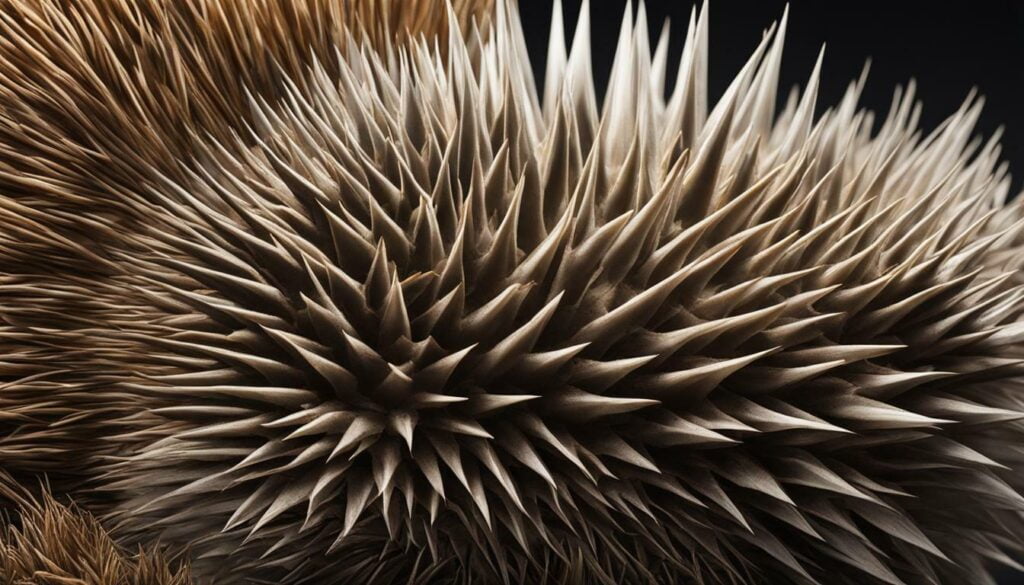
The reddish-orange color of porcupine teeth is a fascinating feature influenced by their diet. As they consume plant material, including tree bark, the iron oxide present in their enamel contributes to the unique coloration. This iron-rich structure not only gives their teeth a distinctive appearance but also provides strength and protection against mechanical stress and acid wear.
In the grand design of nature, porcupine teeth are a masterpiece of adaptation. They offer a window into the dietary habits and survival strategies of these incredible animals. Porcupines have evolved teeth that allow them to thrive on a plant-based diet, demonstrating the ingenuity of nature in its ability to create specialized structures for specific ecological niches.
The Remarkable Teeth of Porcupette: From Birth to Adulthood
Embark on a journey through porcupine parenthood as we discover the fascinating evolution of teeth in baby porcupines. Known as porcupettes, these adorable newborns are born with milk teeth that eventually fall out and are replaced by their permanent teeth, just like human children. Let’s delve into the intriguing development of porcupine teeth in their early stages.
At birth, porcupettes have tiny milk teeth that allow them to nurse and consume their mother’s milk. As they grow, their teeth gradually develop, preparing them for their herbivorous diet of tough plant materials. The transition from milk teeth to permanent teeth is a significant milestone in a porcupine’s life, as it marks their readiness to venture out into the wild and begin foraging on their own.
During this teething phase, porcupines’ teeth continue to grow and develop. Their permanent teeth emerge and gradually replace the milk teeth, enabling them to chew and gnaw on various plant materials, such as tree bark and tough branches. This process helps strengthen their jaws and ensures their teeth are adapted for their plant-based diet. Porcupine teeth growth is continuous throughout their lives, allowing them to efficiently consume the plants that sustain them.
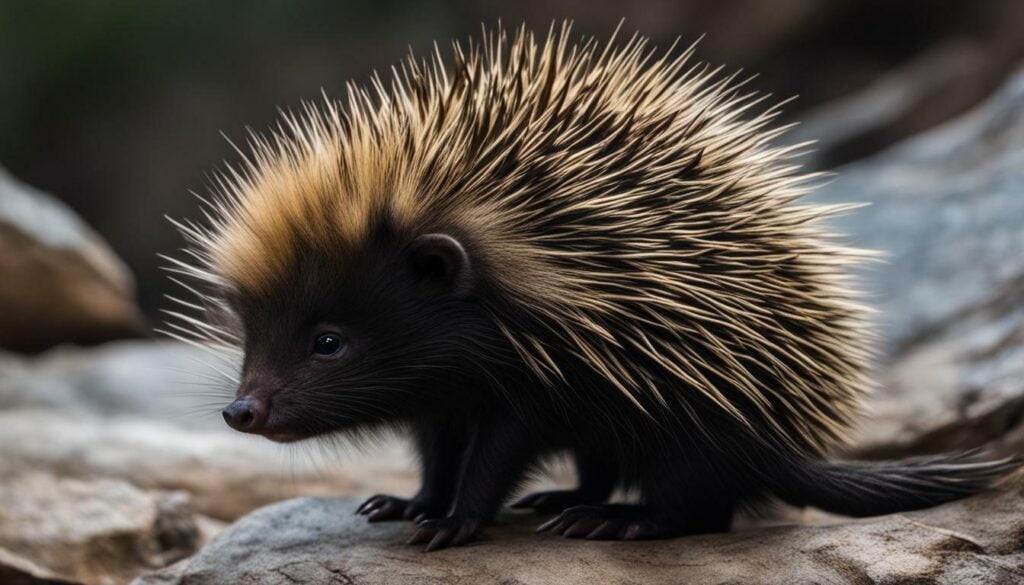
As baby porcupines grow, their teeth become essential tools for their survival in the wild. Whether it’s gnawing on bark for nourishment or defending against predators, porcupines’ teeth play a crucial role in their everyday lives.
| Tooth Development in Porcupettes | Timeline |
|---|---|
| Milk teeth eruption | Shortly after birth |
| Permanent teeth development | Ongoing throughout their first year |
| Completion of teeth development | Between 8 to 12 months |
As we explore the remarkable journey of porcupine teeth from birth to adulthood, we gain a deeper appreciation for the intricacies of nature’s design. The development of their teeth not only enables porcupettes to survive but also reflects the evolutionary adaptations that have allowed these unique creatures to thrive within the animal kingdom.
Porcupine Teeth: A Window into the Animal Kingdom
Unlock the secrets of the animal kingdom through porcupine teeth, as they reveal fascinating insights into the world of rodents and evolutionary adaptations. Porcupines, belonging to the rodent family, are remarkable creatures with unique dental structures. They are the second-largest rodents in the world, with old world porcupines found in South America and the largest species inhabiting North America.
One distinctive dental feature of porcupines is their pronounced diastema, which refers to the gap between their incisors and cheek teeth. This adaptation allows them to chew on tough plant material, like tree bark. Their teeth play a crucial role in their survival by aiding in feeding and defense against predators. As these herbivorous creatures gnaw on items like trees and branches, their teeth continue to grow throughout their lifetime, constantly adapting to their diet and environment.
Porcupine teeth provide valuable insights into the evolutionary adaptations within the animal kingdom. Their teeth’s unique design and continuous growth reflect the ingenuity of nature. These red or orange teeth, colored by iron oxide, are not only aesthetically appealing but also contribute to the strength and durability of porcupine teeth. Their iron-rich enamel protects their teeth from mechanical stress and acid wear, enabling them to thrive in their rocky outcropping habitats.
Porcupine teeth are a testament to the diversity and complexity of dental adaptations in rodents. They offer a fascinating glimpse into the world of these incredible creatures and their remarkable ability to survive and thrive. So next time you come across a porcupine, take a moment to appreciate the intricate beauty and functionality of their teeth, and marvel at the wonders of the animal kingdom.
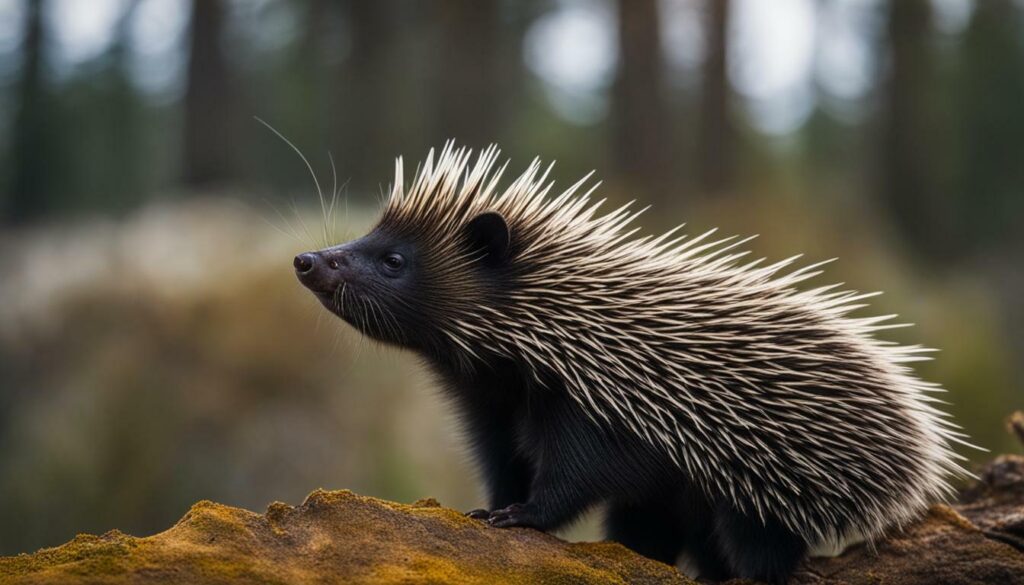
Buckle up as we debunk a common myth surrounding porcupine teeth and shed light on the true strength and durability they possess. It is often mistakenly believed that porcupines have loosely attached teeth that can easily fall out. However, this is a common misconception. In reality, porcupine teeth are firmly attached to their jaws, providing them with the ability to gnaw on tough plant material with ease.
Porcupines, as members of the rodent family, have teeth that are firmly anchored in their skulls. This ensures that their teeth can withstand the pressures of constant chewing, which is necessary for their survival. The strength and durability of their teeth allow porcupines to chew on items like trees and branches, which form a significant part of their diet.
“Porcupine teeth are firmly attached to their jaws, providing them with the ability to gnaw on tough plant material with ease.”
The myth about loosely attached porcupine teeth may have stemmed from the well-known fact that porcupines can shed and regrow their quills. While their quills are loosely attached, serving as a defense mechanism, their teeth are firmly anchored, ensuring their functionality in feeding and survival. This distinction between teeth and quills is important to understand when exploring the unique characteristics of porcupines.
Porcupine Teeth: Strength and Durability
In conclusion, porcupine teeth are not loosely attached as the common myth suggests. On the contrary, they are firmly anchored, providing the strength and durability necessary for these remarkable creatures to survive in the wild. Their teeth play a vital role in their ability to chew on tough plant material, aiding in their dietary needs and overall well-being.
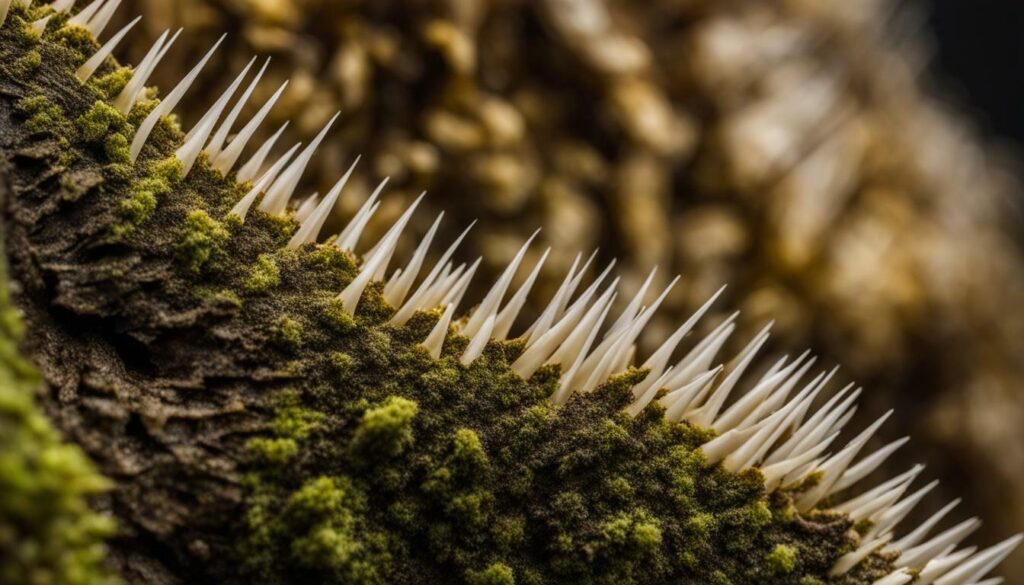
| Myth | Reality |
|---|---|
| Porcupine teeth are loosely attached | Porcupine teeth are firmly anchored |
| Porcupine teeth lack strength and durability | Porcupine teeth are strong and durable |
| Porcupine teeth easily fall out | Porcupine teeth are securely attached to their jaws |
The Unique Tooth Enamel of Porcupines
Delve into the extraordinary world of porcupine tooth enamel, where iron-rich structures contribute to their remarkable strength and protective qualities. Unlike their well-known quills, porcupine teeth are a fascinating feature that sets them apart from other animals. Their teeth are a shade of red or orange, thanks to the iron oxide present in their enamel. This iron-rich composition not only gives their teeth their distinctive coloration but also plays a vital role in their durability.
Porcupines, belonging to the rodent family, have teeth that are perfectly suited for their herbivorous diet. They primarily eat plants, including tree bark, which contributes to the reddish-orange hue of their teeth. The iron in their teeth enables them to gnaw on tough items like trees and branches. It’s truly remarkable to see how the composition of their enamel supports their diet and enables them to thrive in their natural habitat.
One of the most fascinating aspects of porcupine teeth is their continuous growth throughout their lifetime. Their teeth never stop growing, which is why they need to constantly chew on objects to wear them down. This perpetual growth allows porcupines to keep their teeth in optimal condition for consuming their plant-based diet. It’s a remarkable adaptation that showcases the intricate design found in nature.
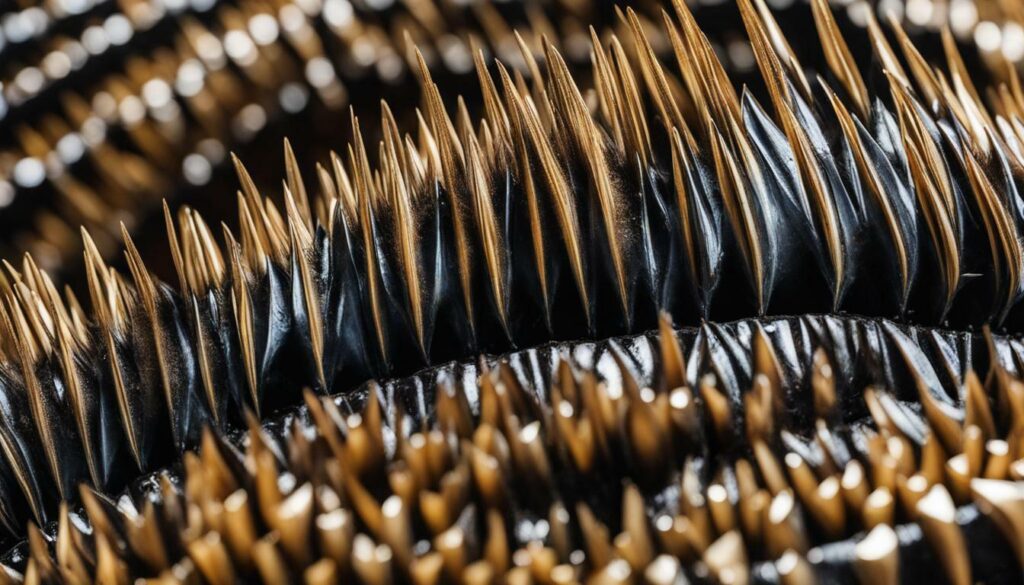
Porcupine tooth enamel is truly a marvel of nature. Its high iron content not only adds to the strength and durability of the teeth but also provides a protective barrier against mechanical stress and acid wear. This unique enamel composition ensures that porcupines’ teeth remain in excellent condition, allowing them to chew through tough plant material and ensuring their survival in the wild.
In conclusion, porcupine tooth enamel is a testament to the ingenuity of nature. The iron-rich structures in their teeth contribute to their remarkable strength, protective qualities, and the ability to adapt to their plant-based diet. These magnificent creatures continue to fascinate us with their unique dental features, highlighting the beauty and complexity found in the animal kingdom.
Porcupine Teeth: Adaptations for Feeding and Survival
Uncover the remarkable adaptations of porcupine teeth, perfectly suited for feeding and survival as they navigate their natural habitat. Porcupines are known for their ability to gnaw on items like trees and branches, thanks to their unique dental structure. Their teeth are specifically adapted for this purpose, allowing them to consume tough plant material with ease.
Porcupine teeth are designed to be specialized for foraging and finding food in their environment. Their incisors, molars, and canines work together to help them chew through bark and other tough plant matter. The constant growth of their teeth ensures that they can continue to gnaw and consume fibrous plant material throughout their lifetime. This adaptation allows porcupines to meet their dietary needs and thrive in their habitat.
“Porcupines are incredible creatures, and their teeth are a testament to the unique design found in nature.”
| Porcupine Teeth Adaptations for Feeding | Porcupine Teeth Adaptations for Survival |
|---|---|
|
|
The dental adaptations of porcupines play a crucial role in their ability to find and consume food, as well as protect themselves from potential threats. These remarkable adaptations demonstrate the ingenuity of nature and the intricate design found in the animal kingdom.

Porcupine teeth are nature’s masterpiece, perfectly crafted for the survival and sustenance of these incredible animals. Their specialized adaptations allow for efficient feeding on tough plant material, while also serving as a defense mechanism. The constant growth of their teeth ensures a lifetime of reliable food foraging.
Porcupines are a fascinating example of how evolution shapes the unique traits and abilities of different species. Their teeth provide valuable insights into the adaptive nature of animals, showcasing the remarkable diversity and complexity of the animal kingdom.
Porcupine Teeth and the Fascinating Iron Content
Dive into the captivating world of iron-infused porcupine teeth, as their high iron content gives rise to their stunning coloration and adds to their remarkable qualities. Unlike their quills, which are well-known for their sharpness, porcupine teeth possess a unique reddish-orange hue. This distinct coloration is attributed to the presence of iron oxide in their enamel, which not only contributes to their aesthetic appeal but also plays a crucial role in their dental strength and durability.
Porcupines, as members of the rodent family, have teeth specially adapted for chewing on tough plant material, such as tree bark. The iron in their teeth enables them to effectively gnaw on items like trees and branches, helping them maintain a plant-based diet. The reddish-orange color of their teeth is a result of the iron-rich composition, which imparts a vibrant and eye-catching shade.
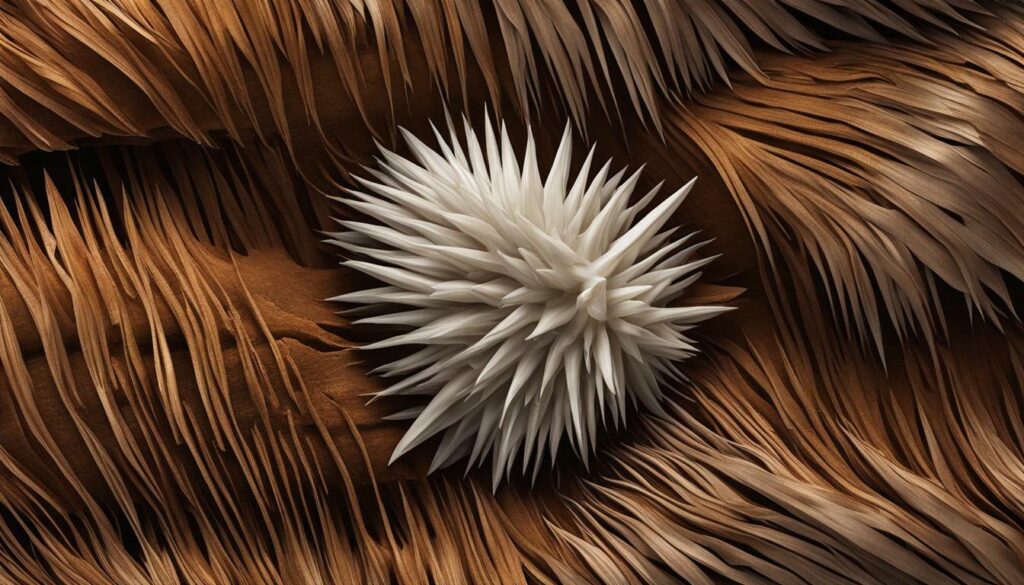
Porcupine teeth constantly grow throughout their lives, necessitating the need to wear them down through continuous chewing. This constant growth, combined with their iron-infused enamel, ensures that porcupines have teeth that are both strong and durable. Their teeth are able to withstand the mechanical stress that comes from gnawing on tough plant material, as well as the wear and tear caused by acid in their diet.
The presence of iron in porcupine teeth not only contributes to their physical properties but also adds to their overall resilience and adaptability. It is a testament to the remarkable design found in nature, where even the smallest details, such as the iron content in teeth, can have a significant impact on an organism’s survival and success.
Porcupine Teeth: A Fascinating Evolutionary Design
Explore the intricate evolutionary design of porcupine teeth, providing a glimpse into the captivating world of dental adaptations in the animal kingdom. Porcupine teeth are truly remarkable, showcasing a unique design that serves multiple functions in their survival. Unlike their well-known quills, porcupine teeth are not only a tool for defense but also essential for their diet and overall well-being.
Porcupines, belonging to the rodent family, have teeth that continuously grow throughout their lives. This constant growth is what enables them to effectively gnaw on items like trees and branches, which form a significant part of their plant-based diet. The reddish-orange color of porcupine teeth is a result of the iron oxide present in their enamel, a feature that contributes to their strength and durability.

Porcupine teeth are a testament to the fascinating adaptations developed through evolution. They are designed to withstand the mechanical stress and acid wear associated with chewing tough plant material. These teeth have evolved to be ever-growing, allowing porcupines to continually maintain a functional set of teeth that aid in their survival.
As we delve into the captivating world of porcupine teeth, we gain insight into the intricate dental adaptations found in the animal kingdom. From their distinctive reddish-orange coloration to their ever-growing nature, porcupine teeth are a prime example of the ingenious designs developed by nature over time. They are a testament to the incredible diversity and adaptations that exist within the animal kingdom, showcasing the wondrous complexity of the natural world.
Porcupine Teeth: Nature’s Masterpiece
Embrace the magnificence of porcupine teeth as we celebrate their status as nature’s exquisite masterpiece, showcasing the marvels of creation within the animal kingdom.
Porcupine teeth are truly remarkable, resembling works of art in their intricate design and unique role. Unlike their well-known quills, the vibrant hue of porcupine teeth is a testament to nature’s ingenuity. The shade of red or orange comes from the iron oxide present in their enamel, which not only provides strength and durability but also protects their teeth from mechanical stress and acid wear.
Belonging to the rodent family, porcupines are relatives of beavers and exhibit fascinating adaptations. Their teeth are perfectly suited for their plant-based diet, enabling them to chew on items like trees and branches. As herbivores, their diet mainly consists of tough plant material, including tree bark, which contributes to the reddish-orange coloration of their teeth. Moreover, porcupine teeth never stop growing, necessitating constant chewing to wear them down and maintain their optimal size.
Porcupine teeth stand as an exceptional example of the wonders found in nature. Their unique design and continuous growth showcase the brilliance of evolution, ensuring the survival and success of these incredible creatures. With their teeth as a natural masterpiece, porcupines demonstrate nature’s grand design, highlighting the intricate and interconnected roles played by different species in the vast scheme of the natural world.
FAQ
Are porcupine teeth really red or orange?
Yes, porcupine teeth are indeed a shade of red or orange. This coloration is due to the iron oxide present in their enamel, which also protects their teeth from mechanical stress and acid wear.
Do porcupine teeth ever stop growing?
No, porcupine teeth never stop growing. They constantly chew on items like trees and branches to wear them down and keep them at a manageable length.
Do porcupines use their teeth for defense?
No, porcupines primarily use their quills for defense. While their teeth are sharp, they are mainly used for chewing and consuming their plant-based diet.
What do porcupines eat?
Porcupines mainly eat plants, including tree bark. Their diet consists of tough plant material, which their teeth are well-adapted for gnawing and chewing on.
How do porcupine teeth compare to their quills?
Porcupine teeth are used for chewing and consuming food, while their quills serve as a defense mechanism. The quills are sharp and prickly, providing protection against predators.
How long do porcupine teeth grow?
Porcupine teeth grow continuously throughout their lifetime. They never stop growing, which is why porcupines constantly chew to wear them down.
What role do porcupine teeth play in their survival?
Porcupine teeth play a crucial role in the survival of these mammals in the wild. They aid in defense against predators and enable porcupines to consume their plant-based diet.
Do baby porcupines have teeth?
Yes, baby porcupines, called porcupettes, are born with milk teeth. These teeth eventually fall out and are replaced by permanent teeth as they grow.
Are porcupines the only animals with unique teeth?
No, there are many animals in the animal kingdom with unique teeth. Porcupine teeth are just one example of the amazing adaptations found in nature.
Are porcupine teeth firmly attached?
Yes, porcupine teeth are firmly attached. Contrary to a common myth, their teeth are not loosely attached but provide strength and durability for their chewing habits.
How does the iron content in porcupine teeth contribute to their coloration?
The iron oxide present in porcupine teeth gives them a reddish-orange color. This unique iron content also contributes to the strength and durability of their teeth.
What makes porcupine teeth a fascinating evolutionary design?
Porcupine teeth are a fascinating evolutionary design due to their unique structure and adaptations for chewing tough plant material and defending against predators. They are a testament to the incredible ingenuity of nature.
Are porcupine teeth considered a masterpiece of nature?
Absolutely! Porcupine teeth are indeed considered a masterpiece of nature. Their intricate design and unique role in the grand scheme of nature’s creations make them a remarkable feature of these incredible animals.

